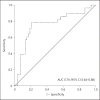Predictors of 90-Day Restart of Renal Replacement Therapy after Discontinuation of Continuous Renal Replacement Therapy, a Prospective Multicenter Study
- PMID: 31330511
- PMCID: PMC6878749
- DOI: 10.1159/000501387
Predictors of 90-Day Restart of Renal Replacement Therapy after Discontinuation of Continuous Renal Replacement Therapy, a Prospective Multicenter Study
Abstract
Background: Restart of renal replacement therapy (RRT) after initial discontinuation of continuous RRT (CRRT) is frequently needed. The aim of the present study was to evaluate whether renal markers after discontinuation of CRRT can predict restart of RRT within 90 days.
Methods: Prospective multicenter observational study in 90 patients, alive, still on the intensive care unit at day 2 after discontinuation of CRRT for expected recovery with urinary neutrophil gelatinase-associated lipocalin (NGAL) available. The endpoint was restart of RRT within 90 days. Baseline and renal characteristics were compared between outcome groups no restart or restart of RRT. Logistic regression and receiver operator characteristic curve analysis were performed to determine the best predictive and discriminative variables.
Results: Restart of RRT was needed in 32/90 (36%) patients. Compared to patients not restarting, patients restarting RRT demonstrated a higher day 2 urinary NGAL, lower day 2 urine output, and higher incremental creatinine ratio (day 2/0). In multivariate analysis, only incremental creatinine ratio (day 2/0) remained independently associated with restart of RRT (OR 5.28, 95% CI 1.45-19.31, p = 0.012). The area under curve for incremental creatinine ratio to discriminate for restart of RRT was 0.76 (95% CI 0.64-0.88). The optimal cutoff was 1.49 (95% CI 1.44-1.62).
Conclusion: In this prospective multicenter study, incremental creatinine ratio (day 2/0) was the best predictor for restart of RRT. Patients with an incremental creatinine ratio at day 2 of 1.5 times creatinine at discontinuation are likely to need RRT within 90 days. These patients might benefit from nephrological follow-up.
Keywords: Acute kidney injury; Continuous renal replacement therapy; Discontinuation; Neutrophil gelatinase-associated lipocalin.
The Author(s). Published by S. Karger AG, Basel.
Conflict of interest statement
The department of intensive care of the Erasmus Medical Centre received an unrestricted research grant from Dirinco. H.O.M.S. is an associate editor of Blood Purification, received speaker”™s honorary, and participated in advisory meetings from Fresenius, Baxter/Gambro, and Dirinco.
Figures




Similar articles
-
Predictors of short-term successful discontinuation of continuous renal replacement therapy: results from a prospective multicentre study.BMC Nephrol. 2019 Apr 15;20(1):129. doi: 10.1186/s12882-019-1327-9. BMC Nephrol. 2019. PMID: 30987604 Free PMC article.
-
The Effect of Serum Neutrophil Gelatinase-Associated Lipocalin on the Discontinuation of Continuous Renal Replacement Therapy in Critically Ill Patients with Acute Kidney Injury.Blood Purif. 2019;48(1):10-17. doi: 10.1159/000499026. Epub 2019 Mar 7. Blood Purif. 2019. PMID: 30844791
-
Different Roles of Functional and Structural Renal Markers Measured at Discontinuation of Renal Replacement Therapy for Acute Kidney Injury.Blood Purif. 2023;52(9-10):786-792. doi: 10.1159/000532034. Epub 2023 Sep 27. Blood Purif. 2023. PMID: 37757763 Free PMC article.
-
Determining the optimal time for liberation from renal replacement therapy in critically ill patients: a systematic review and meta-analysis (DOnE RRT).Crit Care. 2020 Feb 13;24(1):50. doi: 10.1186/s13054-020-2751-8. Crit Care. 2020. PMID: 32054522 Free PMC article.
-
Discontinuation of renal replacement therapy in critically ill patients with severe acute kidney injury: predictive factors of renal function recovery.Int Urol Nephrol. 2018 Oct;50(10):1845-1851. doi: 10.1007/s11255-018-1947-1. Epub 2018 Aug 2. Int Urol Nephrol. 2018. PMID: 30073616 Review.
Cited by
-
Spontaneous diuresis in combination with furosemide stress test (SD-FST) as predictor for successful liberation from kidney replacement therapy: a prospective observational study.Crit Care. 2025 May 26;29(1):214. doi: 10.1186/s13054-025-05452-1. Crit Care. 2025. PMID: 40420285 Free PMC article.
-
[S3 guideline on renal replacement therapy in intensive care medicine : Evidence-based implementation of renal replacement therapy in critically ill patients].Med Klin Intensivmed Notfmed. 2025 Jun 23. doi: 10.1007/s00063-025-01293-6. Online ahead of print. Med Klin Intensivmed Notfmed. 2025. PMID: 40549176 Review. German.
-
Major Adverse Kidney Events in Pediatric Continuous Kidney Replacement Therapy.JAMA Netw Open. 2024 Feb 5;7(2):e240243. doi: 10.1001/jamanetworkopen.2024.0243. JAMA Netw Open. 2024. PMID: 38393726 Free PMC article.
-
Current role of biomarkers in the initiation and weaning of kidney replacement therapy in acute kidney injury.World J Nephrol. 2025 Mar 25;14(1):99802. doi: 10.5527/wjn.v14.i1.99802. World J Nephrol. 2025. PMID: 40134642 Free PMC article. Review.
References
-
- Bagshaw SM, Uchino S, Bellomo R, Morimatsu H, Morgera S, Schetz M, et al. Beginning and Ending Supportive Therapy for the Kidney (BEST Kidney) Investigators Timing of renal replacement therapy and clinical outcomes in critically ill patients with severe acute kidney injury. J Crit Care. 2009 Mar;24((1)):129–40. - PubMed
-
- Bucaloiu ID, Kirchner HL, Norfolk ER, Hartle JE, 2nd, Perkins RM. Increased risk of death and de novo chronic kidney disease following reversible acute kidney injury. Kidney Int. 2012 Mar;81((5)):477–85. - PubMed
-
- Hoste EA, Bagshaw SM, Bellomo R, Cely CM, Colman R, Cruz DN, et al. Epidemiology of acute kidney injury in critically ill patients: the multinational AKI-EPI study. Intensive Care Med. 2015 Aug;41((8)):1411–23. - PubMed
-
- Lin YF, Ko WJ, Chu TS, Chen YS, Wu VC, Chen YM, et al. NSARF Study Group The 90-day mortality and the subsequent renal recovery in critically ill surgical patients requiring acute renal replacement therapy. Am J Surg. 2009 Sep;198((3)):325–32. - PubMed
-
- Cho YS, Lee BK, Lee DH, Jung YH, Lee SM, Park JS, et al. Association of plasma neutrophil gelatinase-associated lipocalin with acute kidney injury and clinical outcome in cardiac arrest survivors depends on the time of measurement. Biomarkers. 2018 Jul;23((5)):487–94. - PubMed
Publication types
MeSH terms
Substances
LinkOut - more resources
Full Text Sources
Other Literature Sources
Miscellaneous

